#where is my soviet or chinese pop
Explore tagged Tumblr posts
Text
大鬼众 Ghostmass - 大抱散 Improvisation for Dusty Ballz - I'm not super into noise rock, but once in a while something knocks my socks off, like this! (Dusty Ballz is the label co-releasing the album.) This album has regular-length tracks; they also have a new album of two longform tracks (below).
Dusty Ballz (UK) and WV Sorcerer Productions (FR) join forces to present two new releases by Beijing-based noise/drone/doom metal group, Ghostmass. In Chinese, “big ghost” is a phrase sometimes used to convey a sense of utter out-of-placeness. If you see a big ghost, you find someone who walks the corporeal world in their own preposterous ways. A big ghost is not a ghost, it does not terrorise, but neither does it belong. It occurred to Li Weisi that this speaks to the very essence of outside music making. One of these days, he started saying “I saw a big ghost playing last night” after going to a very good gig. Ghostmass, then, are a collective of such big ghosts doing music together. Started in 2021 as an improvisation unit based in Beijing, the project gathers kindred souls who share the vision for an open musical space where ghosts feel at home. To this day, the lineup has evolved into some kind of a supergroup of the capital’s music underground: Li Weisi and Li Qing are known more widely as the retro-manic electro-acoustic duo Soviet Pop, and as two thirds of the cult alt-rock act Carsick Cars; Yan Jun has been a veteran experimenter of sounds, words, and ideas for decades across various scenes; the most recent addition to the group was Yang KuKu (YKK), a professional aquascaper who plays music in a band for the first time. While the project grows from a joint passion for drone, doom, and extreme metal, each ghost attends its own duties in building and rebuilding the collective sound of Ghostmass, which stumbles across a trackless delta of harsh noise and free improvisation. In 2023, Ghostmass recorded an improvised session for Dusty Ballz on a hot summer day. The label was told that they would do something jazz. The two tracks on Side B are titled to pay homage to the legacy of late Coltrane. Side A presents an array of ghostly references from an everyday Chinese context: a martial arts fiction masterwork of the Taiwanese “ghost school”, an ancient Taoist master heralding from the ghost valley, a French DIY-music wizard who wanders in Beijing hutongs calling himself “ghost uncle”, and the famous ghost caverns in the Wuyi Mountains where smoky dark oolong tea grows – these references have warrantably turned into ghosts themselves, paling under translation. In a time when being human gives way to humanism, perhaps being ghost promises a more real living reality. Perhaps hell is what we live in right now - who the hell knows - perhaps this is what jazz music should be.
李青 Li Qing: Drums 李維思 Li Weisi: Bass 顏峻 Yan Jun: Electronics, Voice 羊庫庫 Yang Kuku: Electronics, Voice
“The ghost it is, who has come into possession of the Tao, reigns over gods and demons, and gives birth to heavens and earth. It kills the undying, and breathes life into the unborn. The sounds it creates, there is nothing it cannot still, nothing it cannot heave, nothing it cannot destroy, and nothing it cannot make.” “Ghost Meditation” was recorded at GEBI, a legendary underground venue and studio in Yiwu, China. In this album, the band delves into a meditative sonic intensity that lies between drone/doom and harsh noise, drawing inspiration from artists like Sunn O))) and Merzbow, while adding their own eerie vocal and percussion elements. The album evokes a profound sense of stillness amidst chaos. Vast walls of sound blend seamlessly with fragmented noise, creating a heavy, mysterious atmosphere. Each side of the album features a long-form track—“Wu” on Side A and “Hu” on Side B. These titles, though merely onomatopoeic, carry the power to immerse listeners in the depths of dark mountains and rivers, the desolate landscapes.
4 notes
·
View notes
Text
Pop culture after America
This is increasingly something of a thing at present, but this bodes well into the future, the more irrelevant America grows as a superpower. Especially with both Russia and China rising that it's not going to be practical to remain hung up on America in any way, something like China's Tiktok and Genshin Impact have gained substantial international audiences and users. Even CDramas have gained a following overseas, so has hanfu too.
But this is going to grow in the future as America goes into decline, that it's necessary to move on from America as the epicentre of pop culture. It's not going to remain the epicentre of pop culture for long, as some other superpower or more will take its place. It would be particularly horrifying if prophecies about a nuclear holocaust taking place in America were to come true in a way, but then again America nuked its own territories like the Marshall Islands and also reservations.
So white America reaps what it sows, it's going to become a Russian colony and even disappear forever. If you believe some Christians, America's time as a superpower is going to be over as it's Mystery Babylon. The prophesised nation-state said to corrupt the entire world with, where God will do anything and everything to undo American influence. Well most of it would. So this means there will be a new pop culture in its place. In the west, this would be Russia. In the far east (including all of Southeast Asia), it would be China.
It's already happening to an extent with China's Sun Wukong, Genshin Impact and Tiktok gaining traction among westerners and non-Chinese people in general. But the loss of America as a superpower will exacerbate it, to the point where the other BRICS countries will get in the act as well. One would wonder if something like Russia's Soyuzmultfilm will act as an adequate Disney substitute, should Disney go down with America in general.
It could be seen as a Soviet Disney in terms of influence and scope over the Soviet Union, it's also old and still around though nowhere as big as Disney has gotten over the years. Let's not forget that Disney has gotten so huge it's even bought Marvel, Lucasfilm and a good portion of what used to be 21st Century Fox, taking National Geographic along with it. (Disney used to own the Discover magazine before.)
Disney even has a radio network in Latin America, check out the Mexican branch here. Who knows if Soyuzmultfilm will ever become as big as Disney is, only time will tell though I have a feeling it would become the go-for family entertainment brand in the future if Disney also sinks to the bottom with America. It's not that big, but it could become so in the future. Some Chinese companies are big enough to buy American game publishers.
Tencent even owns Riot Games, the makers of Valorant by the way. So there's a good chance that if Russian companies were to get really globally big, they could buy American brands. This has already happened to Livejournal before, it could happen again in the future. But I also think it's just as likely that American brands and franchises would be largely forgotten in the future, sort of like what Celestial said about America as a whole.
She's the one who got me into blogging about God a lot, sometime last year I think, so despite her faults I'm indebted to her. If God could undo much of America's influence, as it's no good, perhaps inevitably not only will American influence be undone but also how and why many American multimedia franchises will be forgotten too. Supposing if I created a character like Akosamesew Kanewopasikot for a video game and he's based on Cassandra Cain.
Both of them would be compared to each other early on, but over time he becomes better remembered than her that future geeks who're thinking of a martial artist who can read body language preternaturally well will name him more. Okay, that's going to be a humblebrag on my part and I do struggle with pride, but this is also an example of how American influence will be forgotten.
Maybe not immediately, but in the future it will be. While it's possible for some older people to remember what America was like as a superpower, including its attendant pop culture, future generations will not remember it and may never even know it at all. Like if God succeeds in erasing most of America's influence and even getting rid of the American landmass, then he's really going to get rid of it in every way.
He'll make people forget about America in the very near future, so conceivably even most old people will forget about America. They'll forget about American pop culture a lot, so from then on almost nobody will remember cartoon characters like Batman, Superman and Spider-Man. If possible, they'd be nearly forgotten. But this means that if God's going to undo most of America's influence by both revoking traces of it and having people forget it, we'd need to make new ones in their place.
Supposing if America becomes more and more irrelevant to most people, especially once it stops becoming a superpower, that it would be necessary to make new memories and new things to grow attached to. While a Canadian superhero mystery game wouldn't have the same brand recognition as DC and Marvel do, especially early on, but because it's a very new approach to something that over time people will grow fond of it.
Whatever that means, but if something like Wonder Woman becomes irrelevant to and forgotten by many, we might as well make a new Wonder Woman. Not exactly like her, but similar to her in stature and scope. The loss of America as a superpower would necessitate substitutes of any kind in its place, particularly when its end as one is very near. So we might have to let go of American franchises and go for something new instead.
It already is happening to an extent these days, but this is going to grow the more irrelevant America becomes.
#genshin impact#black myth wukong#christianity#prophecy#the bible#bible#end times#dc comics#marvel#marvel comics#spider-man#superman#batman#wonder woman#valorant
3 notes
·
View notes
Text
HISTORY MATTERS
Irma and I saw John and his wife off at the Tbilisi train station. They were guests of the Georgian Friendship Society With Foreign Countries. But his wife was born in Venezuela, the daughter of a Georgian-father and a Russian-mother. So Irma, from the Society of Compatriots Living Abroad, assisted me with the program. From Krasnovodsk, their route went through Central Asia by train all the way to Beijing. At the time, head of the CIA in Beijing was Robert Fulton, whom I had known since he was the head of the CIA in the USSR a decade ago. Before the train left Tbilisi, I noticed how a Moscow KGB officer secretly climbed into the next car. Apparently, he was supposed to accompany them along the entire route, since he had specially come from Moscow to Tbilisi. A month later I received a letter from John in a DHL China branded envelope. He thanked me for the reception and advised that Intourist drivers should not go out with bald tires to serve foreigners.
1. History Matters
Max (Manny) Granich (1895-1987) was the younger brother of writer Michael Gold (b. Itzok Granich). He joined the Industrial Workers of the World in 1917, participating in several agricultural organizing campaigns in California. He joined the Communist Party USA sometime in the late 1920s, married Grace Maul who accompanied him to Soviet Union, where he did engineering work, and to China. They had been involved in running an anti-Japanese newspaper in Shanghai from 1935-1937 and supervised Cy Oggins. They left just before the Japanese occupied the International Settlement. Just before the Japanese warrant for their arrest. Upon their return, he served as chauffeur and bodyguard for Earl Browder, and (through 1942) as Managing Editor of China Today. Following the postwar expulsion of Earl Browder, the Graniches distanced themselves from the CPUSA and in 1946 founded Higley Hill Camp (Wilmington, Vermont), a left-wing summer camp for children, which they ran until 1964. Grace Granich died in an automobile accident in 1971. In the 1970s, Manny Granich was active in the Chinese-American Friendship Association and led tours to the People's Republic of China. They wanted to have a public program before President Nixon went to China. Thus began the Southbay Chapter, one of the first five in the country.

Grace and Max Granich, 1971
2. Early history China Society
From John Marienthal. US-China Peoples Friendship Association. South Bay Chapter, Friday, April 4, 2014.
"A young woman reporter at a recent National Convention asked how I became interested in China. Two things about China captured my interest. I had recently finished a degree in geography during which. China, being the biggest developing country in the world, was a major topic. How developing countries were to solve their problems was of interest to me.
"Additionally, after spending a year and a half in the Air Force in the Philippines (’64-’66), I became interested in the Vietnam anti-war movement. While in the Philippines, I had observed SEA Countries and China first hand, and I knew none of these countries was strong enough to storm the beaches of Santa Monica and Los Angeles Calif. I knew we were wrong to be in Vietnam.
"I did some reading, and visited China Books and Periodicals. (Later, in 1975 I worked for China Books) I was intrigued that while China was a Socialist country, some of their ideas might benefit the U.S. So, when in Sept of 1971, a friend approached me about forming a China Peoples Friendship Assn, I was only too willing.
"The SF chapter, which was the first chapter in America, started about the same time. In 1972 a chapter was started in Palo Alto. Within a year, Jack Edelman and others started a chapter in Marin County (North Bay). In 1974 we formed a chapter in Santa Cruz.
"Chapters began popping up all over California and the west. There was a professor and some interested students in Fresno—a chapter was born. There were some people who had been involved in United Nations Assn. work in Sacramento—a chapter was born. Groups formed in Seattle, Portland, Los Angeles, Orange County, West Los Angeles, Long Beach, and San Diego. In 1972 Frank Pestana and others formed a regional network. From the west coast, USCPFA blossomed all over. Former member of Central Committee of the Communist Party of Hawaii, OSS linguist, Koji Ariyoshi and family helped form a Hawaiian chapter. Chapters were formed in the Midwest and the East coast.
"In those days, chapters showed Chinese films and foreign documentaries (i.e. Dr. Joshua Horn film) to add to the small number of speakers we could find. The number of people who had been to China was still very small. In 1973 that changed. Youxie offered each of the three areas of our national organization a six person leadership tour to China. That not only helped organize our group into three areas (west, east, Midwest) but was the beginning of many trips to China.
"In 1974 Youxie offered a limited number of visas to tour groups. Potential travelers underwent interviews and had to promise to do outreach programs upon their return. As the visas were limited, couples were not allowed. As part of the newly-formed Western region, I went with this first commercial group of 30 from Hong Kong to Beijing and back."
In 1986 John went to teach in Shihezi, Xinjiang for a year. In 1987 he returned to live and work in China. In 1989 he was on his fifth trip to China.
0 notes
Text
Bubblegum Black Chapter 8 is now live!
Hello all! It's been nearly three weeks since I posted this chapter, and I've been delaying writing the notes for that long while mostly because I wasn't sure how to talk about the chapter. The focus is Celia and Balalaika talking with one another and very little else, so what little worldbuilding details do I really need to highlight? I think there's some stuff, but by and large the chapter is about these two characters. So let's get into that.
Centara District Exterior: Can you tell I was playing lots of Phantom Liberty when I wrote this? You can, can't you! hasukashii na~
Balalaika's Dress: So this is actually inspired by the latest chapter of the New Girl In The Hood arc, where Balalaika is opening an Art Deco-vibes casino and wears an art-deco-ish dress. Of course, a year and a bit later, all her efforts have come to naught. A big fancy Balalaika figure, similar to the Revy Dominatrix one, has come to be released, by the way, and the dress she wears in that one is not the one I'm using here. According to a guy on reddit, said figure has sculpted and painted nipples underneath the glued-on dress. Never change, Japanese 'hobby' industry, never change.
Father's Corporate Princess: This is kind of important, but I'll likely have Balalaika explain it herself later. Suffice to say that I'm not doing some sort of 'she's part of the Neo Soviet Union', and so Balalaika comes from an oligarch clan tied to a real Russian corporation. Again, though, this is information that shouldn't be buried in the notes.
Celia And Her Cause: I actually have read not one but two fanfictions, both from the 90's era of BGC fic, where Celia pops off a suitcase nuke in GENOM Tower. And goodness knows the idea of Celia trying to only keep GENOM 'in check' is an idea as old as its proposition in Scoop Chase. Look, scroll back through my posts and you'll find me going on a rant about how The Sabers Can't Win just pisses me off as an idea, okay? It's... it is what it is, I guess. Some people will say that it's the only valid interpretation, or will even delight in describing how GENOM collapsing would make everything worse. Fuck, look, this is the same thesis I've advanced in Anatomy of a Lovedoll. You read my fics, you know where I stand on stuff like this. And hey! It provides a good foil to Balalaika, who believes that the world cannot be changed, and desires only to have her little niche on a dying planet.
Dinosaur Meat: Look, if we can 3d print synthetic meat, we can 3d print meat that no longer exists as a gourmet novelty. I am completely serious about this. Also, the Psittacosaurus is a dinosaur that just looks edible:

Yeah. You see it too, don't you? Like a little piggy-chicken thing. Heh.
Islamic Combine: A political entity founded by the Emiratis attempting to unite the Sunni and eventually Islamic world into a new caliphate. Pushing the Russians out of Central Asia to control its mostly-Muslim population was what lead to the Kazakh occupation by the Russian military, and that went supremely badly for all parties involved. Of course Balalaika despises them. About a week or two ago, by the way, I came up with the idea of a third metacorporation besides the Japanese GENOM and the Chinese World Prosperity Corporation, the puppetmasters of the IC, called Sunduq Alkhilafa, or Al-Sunduq (In English: The Caliph's Fund, or The Fund). I'm probably not going to do much with this organization for now, since D-Company is their primary puppet in Roanapur, and as we've seen D-Company is on its way out...
Various Megacorps within the Concern: Okay, here's some Deep STMPD Lore Bullshit to play around with. Fuck all that tragic character stuff with Balalaika trying to impress Celia and failing, we megacorping up in this hizzouse now. Yo. For realsizzles. - Black Orb is basically a spoof of megafunds and private equity giants like BlackRock and Vanguard, predatory funds who in the 2060's control most of the US's economy indirectly. Their practices haven't changed much since the present day, leeching the life out of industries and companies and turning competitive fields into stagnant monopolies where genuine innovation goes to die. - Verdanse I think I already covered, but they're basically Biotechnica in Cyberpunk 2077. They're food monopolists relying on single-celled vertical agriculture to manufacture bioproducts and petrochemicals of all kinds, ostensibly based out of Africa. They relied on old European seed capital to make it big, though, so they're... let's call them African cosplayers. - The Dangote Group is a massive Nigerian industrial conglomerate IRL, and while in this timeline Nigeria's economic fortunes are not what they could be due to the lack of demand for petrochemicals compared to the metals the Congo possesses, I put them in anyway just because I could, and also because it's nice for pasty dudes like me to remind myself that Africa has industry, has government, it's not just Le Dark Continent. Give it a few decades and I imagine the Western perception of Africa will change drastically. -Bharati Megacorps: Well, who survived the Indo-Pakistani nuclear war? Reliance? Mahindra? TATA? Take your pick!
HCLI: I did explain this, right? Remember, Koko's from the animanga Jormungand, where she's part of an arms-dealing / logistics conglomerate called HCLI. Here, though, she's left said corporation for greener pastures in GENOM. Celia's saying she thinks she could play the rest of her family off against Koko, keeping her unable to control the Redevelopment Concern. This goal - Get Koko - will animate much of the battle against the Concern in chapters to come. Of course, the Sabers won't just be fighting the Concern. Things keep getting in the way...
I Woke Up In An Old-ish Bugatti: I know Bugatti only does models on limited runs, instead of doing annual runs. That was a goof on my part.
Bamboo Network: A shorthand for the Chinese business networks of Southeast Asia, which basically run the region. Check the Wikipedia article:
Anyway, that's it. That's the nerd shit. Which this chapter wasn't really about.
Anyway! Next chapter is a big long fight scene, the first battle for Roanapur. It will take time to write, probably until like mid-March or so. I'll do what I can to put it out but IRL demands are ramping up so don't expect anything anytime soon. See you then!
1 note
·
View note
Text
Ok art history and current events (ai) rant underneath
So I know nothing about the history of Soviet Union art, and I feel like this was very intentionally done. The general impression I got while studying art at one of the best Art World conceptual art colleges in the US, was that while the 'western art world' considers Pop Art to be 'True Art', the soviet propaganda machine is ignored and belittled as art done for a purpose rather than any kind of conceptual integrity. This shit gets so annoyingly complicated so fast because even to this day not everyone considers Pop Art to be Art, and the only reason carnegie mellon was basically forced into adding this to their world view was because andy warhol was a very hilarious very petty very bitter man who donated a fuck ton of money to the school just so he could laugh at the assholes who treated him like shit when he was a student being made to worship the ground he now walks on.
Anyway my probably very unclear point here is that the saying art isn't Art until someone (the right people) say it's so...is very very true. And in my college soviet art was not Art and was not discussed like at all.
The idea behind ignoring that entire era of russian art history was mostly based on the fact that it was 'propaganda', meaning commissioned and designed by the state for some communal purpose.
Versus Pop Art which was seen as a reaction to the commercialism of the 50's/60's - which was itself a reaction to the threat of communism. The tomato soup can graphic was originally created to sell soup cans. Andy warhol took that graphic and used it conceptually to critique the commodification of art and culture and blah blah blah (dont kill me i actually dont like andy's work i think its interesting as a concept but i also just think its ugly)(i actually really hate the conceit of Pop Art as a whole because i think it demeans the working class artists and designers who contributed to the original iconography of commercials/ads)(you may think im adding capital letters as a form of respect but no im mocking it for it's own inflated self importance)(the fact that an image or object has to be in a museum to be considered valuable by the higher classes who have the money to patronize these gallery artists...but it's identical to an image or object that already exists??? Hmm.)(ANYWAY lol)
So what I'm saying is that kind of like hobey baker, the Art World (caps to mock them for their self importance again) believes that Art is done for the love of art, rather than financial compensation or to survive. Propaganda is seen as the horrifying opposite of this. Propaganda is controlled art. It's art coming from a very isolated culture and dictated by government ideas rather than any kind of self expression. We see this with china too - my college did an entire unit on the tradition of calligraphy and ancient chinese painting. But the minute you start to talk about chinese propaganda art, the Art World doesn't really care. From the perspective of the Western Art World it's like we are supposed to see the communist eras of places like russia and china as being so utterly suppressed that it was devoid of art. I can't name a single painter from that time period from those countries. But we learned a heck of a lot about painters from western countries, south american countries, even when some of those places were going through some interesting political upheaval.
That was a very very long winded way of saying I don't have any basis of comparison within soviet art for this statue. My personal favorite eras of sculpture were the native pacific northwest (for obvious reason), indian art, and mayan and aztec art. I actually find italian sculpture really boring (please dont kill me for this either i blame my great grandpa who supposedly hated the home country, it must be passed down in my genes). So that's where im coming from.
This 'home front' sculpture is fascinating. From a technical standpoint there are a lot of things i dont like - things that i would look at in a sculpture and immediately be like no that needs to have more intention. There's a lot of folds that don't make much sense both in terms of form and the lines they create on the surface of the statue. The strange stylization of the blocky knee that isn't consistent with the rest of the statue is interesting. There are some parts of the stylization i do like - i like how the guy on the left feels like he is stepping out of a huge obelisk. Like he is the obelisk, a pillar of strength and immovable. The stark line of his cape/robe thing works amazingly well. And the way it cups around the statue's body is so good. That one section is done so well that it's part of why the other folds dont make any sense, lol.
But the singular part that really really stands out to me and the part that I would probably be interested in sketching in person? Those hands! Those gestures are gorgeous. The getsure is soft, but with that squared off stylization that the rest of the statue tries to hit. They are lifelike and beautiful in a larger than life way. You can kinda tell that whoever designed this probably had a thing for studying hands - the rest of the sculpture feels a little phoned in but those hands are spectacular. That one hand gripping the hilt of the sword? Omg I can feel that! There's a good chance that this was all intentionally done. After all, the strength of a worker, especially in an era of specialized industry such as WWII, is usually portrayed as being in the worker's hands. Or maybe, as I mentioned, the artist just really loved hands, and absolutely hated faces. Because wow, that's like bare minimum effort on a face sculpt. You know the old joke about like the medieval western european artists whose drawings of lions looked like they'd never seen a lion...because they had never seen a lion? Well i can't say i'm convinced that this sculpture artist has ever seen a real human face. But the hands are great!
So what does all of this have to do with ai?
Well, remember the whole reason for the disdain of propaganda type art was because it's seen as coming from the collective brain of a ruling government's philosophy. But now - and please don't get too mad at me for this either, this is just a half formed thought - ai has put that kind of power into the hands of whoever has an ai image generator trained on the world's art.
Historically governmental bodies and artists tend to clash - right? Like wouldn't it be great for a goverment to be able to erase the pesky need for an artist altogether? Just plug in some words, a 'concept', and watch the image magically unfold in perfect form. This fits with what propaganda believes is the true value of art - the idea behind it. The art itself is just this object, this image. The idea - and the powerful wealthy person behind it ordering this idea- is what is valuable.
Which is hilariously very close to the central values of Western Art World 'conceptual art' but we'll ignore that. (talk to me some time about the exploited labor of assistants to 'big name' artists like that shitty diamond skull dude who shall not be named or even beloved artists like chihuly)
Anyway, we are watching this happen in real time - the people in power in corporations appear to be actively trying to devalue the work of creating art. Corporations are saying essentially that the important part of this process, the part worth paying for, is the 'idea' and not the product of that. This is nothing new, but this form of so called 'artificial intelligence' aka machine learning, makes it much much easier to try to turn artists into middle men that need to be gotten rid of.
Blah blah blah, I'm talking a lot, I know. But I've also been seeing a lot of posts going around tumblr claiming that the root cause of all of this ai is 'Capitalism'. Which, like. Valid in a lot of ways - the inherrent greed of unchecked capitalism causes a wealth inequality that grows until the stratification of classes is as bad as it was under monarchies. But I feel like people being so focused on that being a buzzword for the newest Big Evil to rally against means people are mindlessly not bothering to deconstruct what is actually happening and finding similarities in history when we've seen - not this exact technology and circumstances - but a similar shift in values and thought. We as human beings are so great at labeling things - this is the Good Thing, this is the Bad Thing, that I think we ignore the fact that the actually bad stuff happening - consolidated power and wealth in the hands of a tiny group hivemind dictating cultural creative output for example - is actually really similar throughout history no matter what label gets slapped onto it.
Yeah, i think too much.
Happy Friday! I will return to regular mindless blogging after this I promise. And I swear I'll be up at 7am to watch some russian hockey which historically has been it's own form of fascinating artistry. Yay! \o/ if anyone wants to chat about this stuff feel free to message me though i have been bad about responding to people lately (sorry guys there is one of me and thousands of you :( but also depression)
here is a fun poll for anyone crazy enough to read this whole stupid essay:
if anyone votes for my favorite i will be sad.
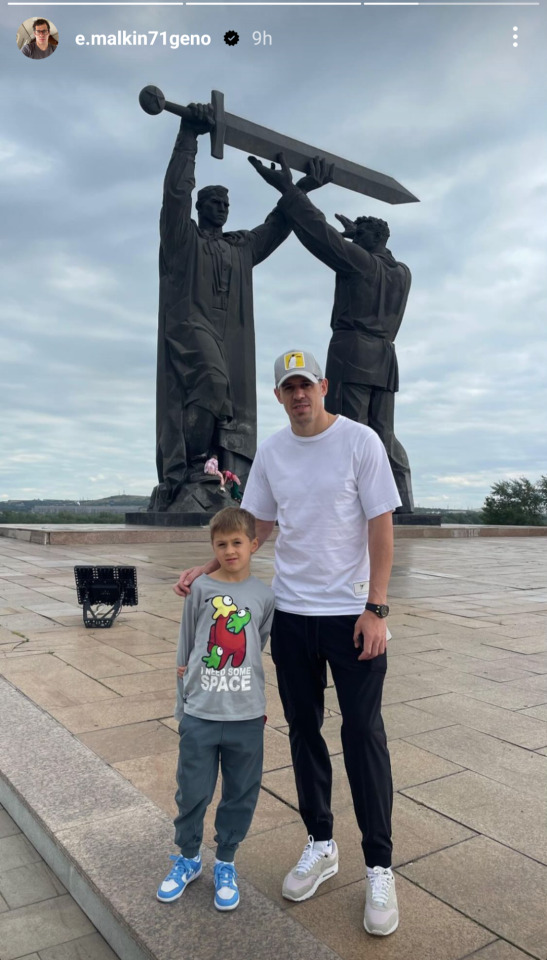
Ok let's talk about art and history, and some of the weird stuff I see it morphing into lately cause I have way too much time to think right now and am anxiously awaiting news that I don't want to think about so instead I am putting on my 'i-was-the-one-person-who-sat-up-front-and-stayed-awake-for-my-entire-traditional-college-art-history-course-and-laughed-at-all-the-professor's-jokes-that-insinuated-he-hated-his-job-and-the-curriculum-he-was-teaching' hat.
Actually scratch that. I'm going to post this and THEN reblog it with my rant so i dont have to fucking censor everything i talk about fuck u tumblr and ur stupid autotag bullshit.
#Jrnlsht#My history art professor is rolling in his grave#I dont think he is actually dead but if he read this he might die and roll in his grave anyway#For a college that was supposedly all about teaching conceptual art#We werent really supposed to think too much we were just supposed to reference other people who were older and more intellient than us#No shade on my college art history professor i thought he was the most snidely hilarious guy ever#He looked down on everyone equally
15 notes
·
View notes
Note
asking explicitly for the sake of a minor squibble with my dad: are you implying that the fact that Die Hard is dated by those aspects makes it worse as a movie?
This is what the refrance, specifically
Extremely dated in every way, from the European villains to the lack of AK-47's and RPG-7's to the idea of an upstart Japanese megacorp instead of a Chinese one.
It doesn't make it worse, it dates it the way someone using a payphone dates something. A few years later terrorists could never casually blow the top off a tall building (they still could, but it would have significantly more gravitas), and their negotiation stall wouldn't be about freeing communists. They'd probably be actual terrorists, since "we're just terrorists" was only less bad than "we're stealing a ton of money" for a narrow window, like how being in a plane hijacking used to be just like. A fun detour to Cuba for the family.
The AK-47 and RPG-7 were almost impossible to get in the USA due to import bans until the late 90's, post fall of the Soviet Union, so they weren't going to show up in movies most of the time. It was still The Symbol Of The Revolutionaries, rather than what it is now, The Symbol Of Dirt Farmers Blowing Up Your Forty Million Dollar Tank With An IED.
Heck, the Signature Villain Gun in Die Hard is a Steyr AUG, the P90 of its time. A weird-ass techy-looking foreign bullpup has a nice identifiable shape and it looks dangerous, if they made Die Hard now they'd absolutely give that guy the long-barreled P90 instead.
This is more about the culture of movies and the presentation of terrorism (and culture in general) in media around the late 80's and early 90's, before terrorism being a fixture of daily news and before China became the new Japan.
That one shows up a lot! Cyberpunk and sci-fi stuff from 70's into the 90's fully believed that Japan's economic miracle would continue forever, but then they had their stock bubble burst in the early 90's and they're dealing with falling fertility rates now, and China is the new land of opportunity where culture and technology is running away under the nose of the decrepit American empire. Snow Crash came out just before the Japanese Asset Bubble burst and it shows.
Whether China is going to undergo a similar thing post Evergrande-scale fiascos and all our posturing about China swallowing the world will fall flat, or if they'll recover and become the new global superpower is pretty much the next thirty years I guess.
Perhaps in a few decades we'll start hearing about a hot new C-pop (Congolese Pop) trend among the Teens.
15 notes
·
View notes
Text
Hanoi, Vietnam
Day 165 – Luang Prabang to Hanoi, Vietnam
I spent my final morning in Luang Prabang at Joma Café, a delicious bakery/café that my uncle Alan had recommended, run by a Canadian expat! I was surprised (and very excited) that the café served Canada’s famous Nanaimo Bar, and picked up one to have a ‘taste of home’ along with my coffee. I tucked into a cozy booth for several hours, doing research and bookings for the final 5 weeks of my trip, including Vietnam, Cambodia, Bangkok and Japan.
In the late afternoon, I packed up my bag and headed to the town centre to hire a Tuk Tuk to take me to the airport. At this point in Southeast Asia, I had become pretty used to negotiating a price when taking a Tuk Tuk, and agreed upon a price with the driver. However, he ended up demanding a higher price at the airport, after we had arrived. Even after months of travel, I was still never quite sure what to do in these situations, which occasionally arose. Given the increased charge that the driver demanded was little more than 50c Canadian, it felt petty to argue over such a small amount. At the same time, the whole practice also felt dishonest, and I struggled with it in principle – particularly wondering in the back of my mind whether I was a target of arbitrary price increases because I was a woman travelling alone. Irritated but not wanting to argue, I grudgingly paid the full amount and headed into the airport to catch my flight to Hanoi.
After a short flight to the east, I touched down in Vietnam just as the sun was setting. Having secured my e-visa to the country in advance, I sailed through customs and into the arrivals hall, where I had pre-arranged an airport transfer to take me into the old town of the city. While I generally preferred to take public transit or hail a tuk-tuk when backpacking, I had become cautious with my transportation when arriving at airports after dark. From my research on Hanoi, I had heard that taxi scams are unfortunately common, where certain drivers are paid by hotels and hostels to drive unwitting passengers to the wrong location, or charge excessive fares, to the point where a passenger would need to go to an ATM, or pay in foreign currency. In the communication I had received in advance from my hostel in Hanoi, I had also been fully briefed on possible scams in transit, and chose to pre-pay for a transfer to avoid the worry. I had also purchased a new Vietnamese SIM card in the airport, so that I could ensure I could follow my route to the old town city.
As my ride pulled away from the airport, we were almost immediately surrounded by scooters – hundreds of them! Weaving in and out of traffic, the drivers leaned heavily on their horns as they navigated their scooters along the road - carrying everything from tall plants, flowers and produce, and sometimes up to 3-4 people! After the quiet atmosphere of Luang Prabang, where honking was rare in the old city centre, the streets of Hanoi were quite the opposite, bursting with sounds from every direction. Heading South, we crossed the Red River and approached the Old Quarter of the city.
As it happened, even with my pre-arranged airport transfer, my driver still tried to drop me off at the wrong hostel. Fortunately I had already located my correct destination in Hanoi on Google Maps, and after much back-and-forth, and insistence on my part, I was finally taken to the correct destination. The streets of the old quarter are so narrow that cars cannot go down them, and I walked the final few minutes to my hostel on foot. I passed other hostels with live music, and food vendors with plastic stools arranged near their stalls for people to sit and eat. My friends from Vancouver, Kevin and Liane, had previously stayed at this hostel, Original Backpackers, a few years earlier, and recommended it highly – and rightly so! I felt immediately welcomed by the friendly staff, and began to relax again after many hours in transit. After several weeks of communal living, I had decided to pay a small premium for a private room, where I had a long, hot shower, before crashing immediately for the night.
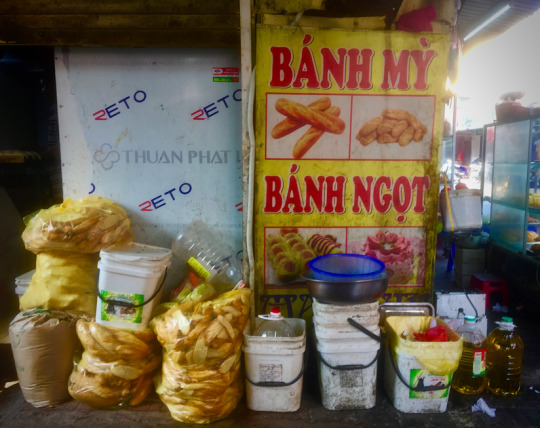
Typical Food Stalls in the Old Quarter
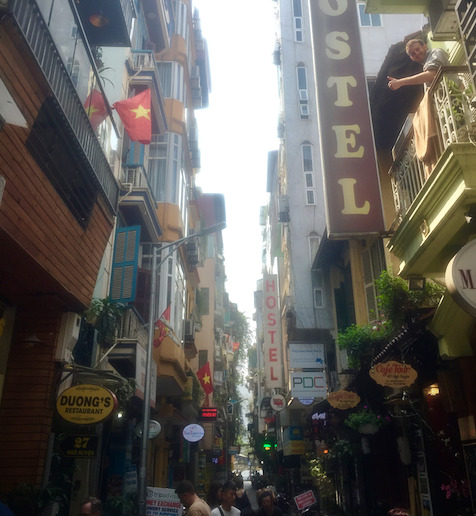
Narrow Streets in the Old Quarter, with a perfectly placed photobomber!
Day 166 – Hanoi
I only had one full day in Hanoi – and woke up early, determined to pack in as much as possible! Through the front desk of my hostel, I arranged a motorbike “Backstreet Tour” for that afternoon, where a local Vietnamese guide would take me around the city on a motorbike to show me both popular sites, and what day-to-day life looked like in Hanoi.
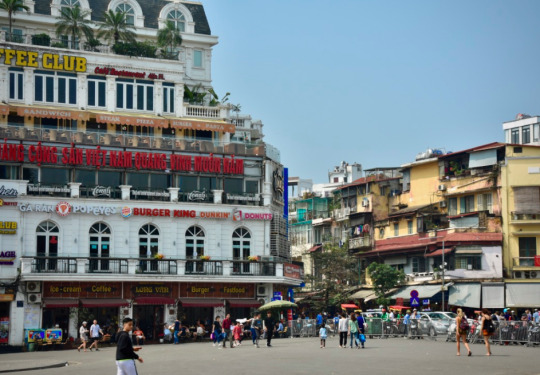
In the morning, I began to wander the Old Quarter of Hanoi nearby to my hostel. This historic city has been inhabited for over a thousand years, and has been shaped by a complex history – from ancient kingdoms, dynasties and wars, French colonialism, Japanese occupation during the second world war, to more recently, with the influences of communism and the Vietnam War. After the war ended in the 1970s, it wasn’t until 1990s that the country began to open up to the outside world again, bringing in new opportunities for tourism and economic development. Modern day Hanoi is home to a multi-cultural community with strong French, Chinese and Russian influences. French colonial architecture continues to be visible throughout the city, with some streets resembling historic neighbourhoods in Paris. Near the Old Quarter, a large gothic cathedral constructed by French still stands; St. Josephs is one of the first structures built by the colonialists as they expanded their reach into Southeast Asia. Remarkably, the cathedral is still in good condition despite the wars of the last century.
The Old Quarter, part of a former citadel wall, is made up of a narrow series of alleys, tightly packed together. The historic area is known for its clusters of workshops, skilled craftsman, artisans and guilds, with the 40 streets of the area each named for the primary good and service provided on each street. It was a lively place to wander through in the morning; locals sat down on low, colourful plastic stools set up by street vendors, eating a breakfast of noodles. Honking scooters whizzed up and down the alleys, narrowing dodging each other. I spotted a few people playing chess in a doorway, right next to a vendor selling produce off the back of a scooter. I passed through one street mostly selling flowers, before turning the corner to find another street with almost all bamboo products.
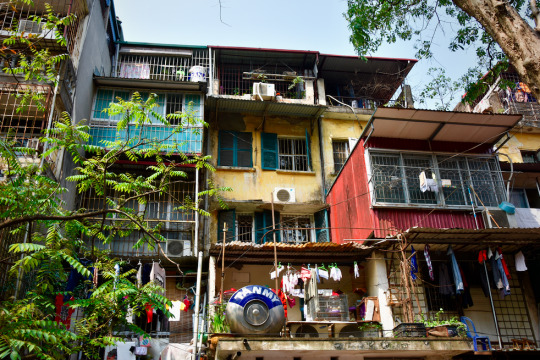
I wandered further east to Hoan Kiem Lake, finally making an attempt to cross a major street – with scooters, cars and pedestrians going in every which way! One good piece of advice I had been given by friends who had visited Hanoi was to simply walk out into traffic at a slow, steady pace (without any sudden moves or stops!) and the scooters would simply weave around you. I walked beside locals crossing on my first few attempts, but it wasn’t long before I got the hang of it!
I stopped at Note Coffee to try my first Vietnamese-style egg coffee. This drink is traditionally prepared by beating egg yolks with sugar and milk, and bringing this mixture to a boil, before pouring in coffee. The result is a foamy, dessert-like coffee – and was delicious! The café itself was also unusual – with its walls decorated with thousands upon thousands of colourful post-it notes, with messages from previous visitors. The result made the entire café look like a giant art installation, and reminded me of Yayoi Kusama’s dotted “obliteration room”. Sufficiently loaded up on sugar and caffeine, I continued onwards towards the lake, popping into a few art galleries and stalls on my way. Along the streets, I was constantly amazed by the number of vendors selling fruit, art, and countless other items off the back of their scooters. Pushing or driving their laden motorbike through the crowds, these vendors would make sales right, left and centre – all while keeping moving!
Arriving at the banks of Hoan Kiem Lake, I crossed a traditional, red wooden bridge to Ngoc Son Temple, located on a small island in the middle of the lake. Aside from the crowds of other tourists, it was a quiet respite from the buzz of the surrounding Old City of Hanoi.
As it was approaching noon, I returned to my hostel to meet Kien, my local guide for the afternoon motorbike tour. Slightly younger than me, Kien had grown up in Hanoi, and was excellent company for the afternoon. His motorbike was a vintage, army-green, “Minsk”, a heavy duty motorbike that was brought back from the Soviet Union in the 80s. As luck would have it – I was the only person on the tour that day, which allowed Kien to take me out and around the city for almost 7 hours! I could scarcely believe that I was able to see and experience so much of Hanoi in a day.
Kien first took me to Train Street, where twice a day a speeding train passes through the Old Quarter, mere feet from the front stoops of people’s homes. We continued onwards to Hanoi’s notorious black market, where vendors sell everything from car and mechanical parts to appliances, DVDs and electronics. Kien pointed out things as we cycled; the dense scramble of black electric wires overhead called “black noodles” by the locals; the French colonial architecture throughout the city; and the “tube houses” of the Old Quarter – narrow homes that exchanged their width for height and depth – as a way of lowering property tax, since the wider your house, the more you pay! Many of these tall, skinny homes had large water cannisters mounted on the top of the buildings, used to maintain water pressure. We also visited a few wet markets – where every imaginable item was for sale, from a rainbow of produce to live turtles, eels, and frogs.
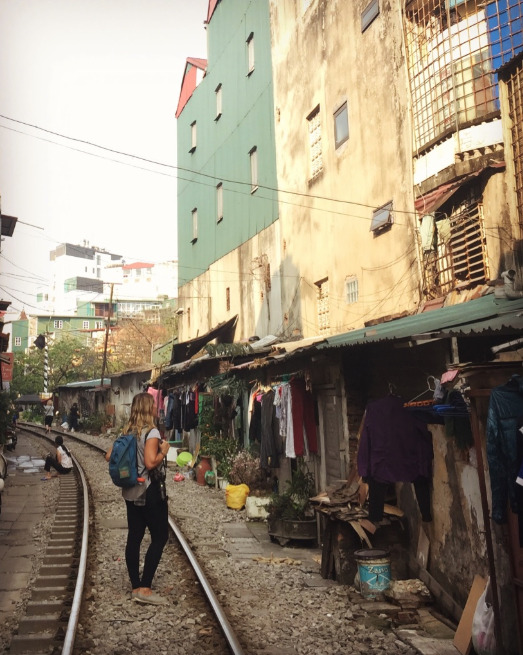
Train Street
Between our ventures into different areas of the city, Kien took me to many local restaurants and wet markets along the way, to try a wide range of different Vietnamese food, including more Ca Phe Trung (egg coffee), Banh Mi Chao (a hearty breakfast skillet), Banh Cuon (rice rolls, stuffed with pork), Pho Cuon (fresh beef rolls), Pho, and Banana Flower Salad. We also stopped at a tiny Bia Hoi right stand next to the road – “Bia Hoi” literally translating to “fresh beer”, and is draught beer that is sold on street corners and tiny bars throughout the city. It is delivered daily and is tapped straight out of a large steel barrel. Kien and I sat on tiny red plastic stools on the pavement, sipping the light beer and snacking on roasted peanuts from a nearby vendor.
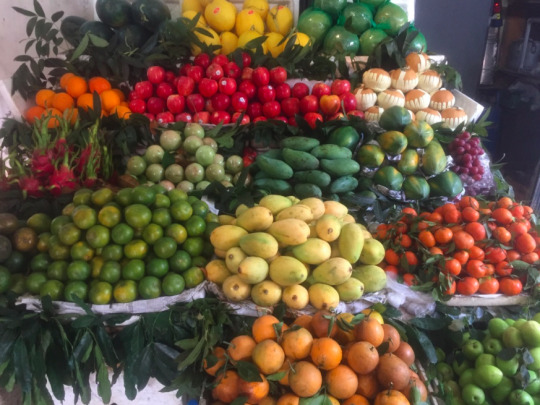
Fruit Markets

A typical neighbourhood Bia Hoi Stand
A particularly interesting part of the day is when Kien took me East of the city center to the banks of the Red River. I was able to walk along Cau Long Bien, a colonial-era cantilever bridge that was heavily bombarded during the Vietnam war, as it was a key point of connection between Hanoi and the nearby port. Spanning a mile and a half in length, it is still one of the longest cantilever truss bridges in the world. While only part of the original bridge still stands, the bridge continues to be a symbol of pride for the Vietnamese people. Underneath the Cau Long Bien, impoverished families live in a cluster of floating homes, make-shift shelters that have been built on rafts of plastic barrels.
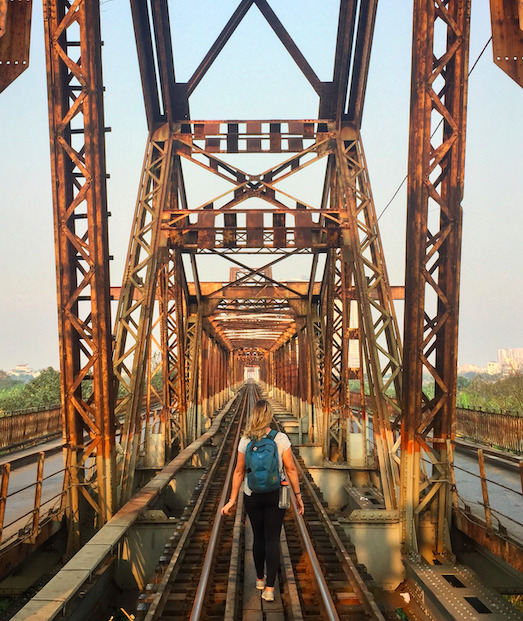
Cau Long Bien

Floating Homes on the Delta
We continued onwards to Bai Giua, or “Banana Island”, an island located in the middle of the Red River next to Hanoi. Since this island is on a flood plain, no apartments or concrete buildings are allowed, and the island is mostly used for farming, including fields of bananas and papayas. Kien maneouvered his motorcycle down a maze of dirt paths between the fields as we explored the island. Barking dogs sometimes came up to our motorcycle, and ran along next to us for a while, before dropping off the trail again. We passed by many farmers working in the fields, typically wearing a conical, straw hat, (called “Non La”) tied around the wearer’s chin with a piece of cloth. These multi-purpose hats not only protect farmers from the fierce tropical sun, but can be used as a fan and also as a basin for water.

As the sun began to set over the Red River, we headed back into Hanoi, and drove along the large, tree lined boulevards around the Ho Chi Minh Mausoleum and the Presidential Palace. Our day ended with a bit of a surprise - as Kien’s motorcycle broke down in the middle of an intersection! Fortunately, this seemed to be a common-enough occurrence in Hanoi, and all the other bikes moved around us seamlessly as we tried to get off the road. All in a day’s adventure! Arriving back in the Old Quarter after a terrific day of exploring Hanoi, I quickly crashed for the night, as I would be waking up early the following morning to catch a bus into the Sapa Mountains, a day’s journey northwest of Hanoi.
1 note
·
View note
Text
Hall of Shadows Critical Review Report
Hall of Shadows: An exploration of Australian war crimes and missing information
“I am not going to pass any judgment on the policy of devastating the country. I obey orders, and perhaps it is a wise plan.”
-RL Wallace, The Australians at the Boer War
WHAT:
Hall of Shadows is a mixed media exploration of war crimes by Australians during conflicts in Afghanistan as detailed by The Brereton Report, an extensively redacted investigation into the deaths of civilians and prisoners. Utilising wet plate collodion tintypes and printed materials taken from digital media, Hall of Shadows focuses on creating a visual mirror to our society to see the far-reaching human cost of these war crimes. The work is about reflecting upon the special operations soldiers who committed the crimes, the political and civil authorities who placed them in these situations on behalf of the civilian population and the media who report on the crimes and the report itself.
The work consists of a grid of 15 wet plate collodion tintype still lifes of toy soldiers in miniature dioramas constructed of wooden blocks, along with four A1 sized newsprint banners in various states of use and disrepair. The tintypes are an echo of, and inspired by, the Hall of Memory at the Australian War Memorial in Canberra, which houses 15 stained glass windows, each with a word that is a quality of Australians at war. The form of the banners was influenced by Chinese hanging scrolls, intended for short-term news and propaganda dissemination. The materiality, plasticity, texture, and imperfections of the toy soldiers I had used as subjects in creating the still lifes for my wet plates was underscored to draw the viewer's attention to in the banners. The banners are images taken directly from the pages of the heavily redacted report overlaid with pictures of plastic toy soldiers.
Both works are meant to evoke reflection in viewers. Where the original stained glass windows are lushly coloured and use a Deco font, the tintypes are monochrome and the words scratched into the surface of the metal. The banners are printed on flimsy, disposable newsprint, and with much of the text unreadable.
WHY:
Australia has an ambivalent relationship with military engagement. The Department of Veteran Affairs (DVA) estimates that approximately 2% of the population are veterans, yet there appears to be a disproportionate emphasis, even a reverence, for military action in popular culture. The large sections of military history and accounts which glamourise the military found in books stores reveals something about the popularity and hunger for information about this segment of our society. But much like sports figures whose poor or inappropriate behaviour is overlooked or excused, soldiers and military action are often elevated to positions above critique or reflection or only examined on Anzac Day then forgotten until the next year.
This work was created in hope of raising some questions for the viewer:
Who am I in relationship to these people and events?
How does my image of this history correspond to lived realities?
What agency, if any do I have relative to these events?
Factors that emerged during the creation of the work included the fact that the greater the temporal distance became between the report’s release (November 2020) and the present, the more of a collective and communal shrug there seemed to be about these crimes and any consequences for those who committed them. This seeming public lack of interest led towards processes and materials that were disposable, recyclable, non-permanent and dismissible, just as the acts which were the genesis of the report and the public response to it appeared to be a part of an ever-churning news cycle. The work was created to be both fixed in history with elements of discard and disposability.
WHO:
This work occurs and is informed by a number of photographic, artistic, military and societal communities. Photographically, a historical process is employed in the tintypes and more modern, digital-descended processes for the scrolls. The incorporation of text to both sets of images is relative to the work of Duane Michals, while wet plate photography has been employed extensively by Sally Mann. The use of miniature diorama and tableaus akin to David Levinthal’s work using toy soldiers and dolls was an important example of how applying good technical skills to small subjects can heighten the impact of images. His series Hitler Moves East is a slightly more abstracted work emulating black and white war photographs contemporary to the historical period of 1939-1945.
Returning to the work of Hiroshi Sugimoto and his photographs of diorama’s in museums also proved inspirationally fruitful. Sugimoto’s concept of photographing a faux re-creation of a time, place and event, had significant overlap and relationship to the work in creating the miniature dioramas as backgrounds I was staging seemed particularly relevant to my investigations. Of particular interest and insight is Sugimoto’s observation that “However fake the subject, once photographed, it’s as good as real.”
Roy Lichtenstein’s pop art, particularly, his work Whaam! seemed to share a print-pixelated, quasi-comic book quality the the scrolls/banners. While it initially felt that a connection might exist to the disposable aspect of Lichtenstein’s work, these images seemed less satisfying at communicating more realistic figures of the toy soldiers. The hope for more identification with soldier’s as the subject, rather than objectification simply wasn’t achieved, and so a more realist approach was adopted. (Note: the Lichtenstein Foundation’s website seems abandoned at this point and is available only through internet archives. I include his citation in Wikipedia for reference purposes.
Liz Wells observations about the truth or non-truth and historical uses of photography in commenting upon war continued to be a touchstone. Especially her observation about the uses of photography in establishing and reinforcing communal sentiments about war. “[T]here are no unequivocally great photographs of war, only those that structure or re-enforce feelings already extant within a particular culture.”
Additionally, the work of Alexander Rodchenko was examined, particularly the shift in his work from documentary photography to its use as propaganda. Rodchenko had good reason to make this turn: survival. As the young Soviet state went from photographic and cinematic playground to a more authoritarian state, photographers found ways to either praise Stalin and the new state or perish. In my work I was seeking to neither laud soldiers nor condemn them, but rather, hold up a mirror to the viewer to examine their own conceptions, pre-conceptions and mis-conceptions about military action and those who carry out the policies of the state, especially in ambiguous environments.
How:
The work was realised through a close reading of the available documents, reflection on my own experience in the Afghanistan theatre of operations, and testing with select trusted voices about the efficacy of whether intended messages were being communicated. This last was a necessary counter-balance to a body of work that was grounded deeply in personal experience. The challenge in this path is getting lost in a personal echo chamber where what seems obvious to the creator is completely unreadable to the viewer. Listening to my supervisor, peers and close friend’s readings of the work was exceptionally helpful in maintaining this balance.
With regard to the wet plates, arranging and mounting the images as a call/response to the sacred and mythological tones of the stained glass windows in Canberra was done as a means to open a door to reflection about their own position relative to military engagement. The limitations and ‘defects’ inherent in wet plates was also a desired element of the work. Just as no plate can be clinically ‘perfect,’ so no military action is without casualties.
The later-developed hanging scroll banners afforded an opportunity to use their materiality as fragile, disposable objects that, in their physical structure, reflected the ephemerality of the impact of the news cycle on our collective attention span. This, in turn, allowed for them to develop as a seperate, unified work on their own, standing along side, but different from the wet plate works.
Best practices for health and safety, including mental well-being, were followed throughout the creation of the work.
Test/Speculative Images:
Finalised plate samples, prior to mounting & framing:
Bibliography
Batchen, Geoffrey. (2004.) Forget Me Not: Photography & Remembrance. 1st ed., New York: Princeton Architectural Press.
Laurent, Olivier. (June 15, 2015.) “A Photographer Turns Real-Life Soldiers Into Toys.” Time. Accessed March 10, 2021. time.com/3911329/a-photographer-turns-real-life-soldiers-into-toys/.
Levinthal, David. (1972-75.) “Hitler Moves East.” David Levinthal. Accessed May 28, 2021. davidlevinthal.com/artwork/hme.html.
Sugimoto, Hiroshi. (1994.) “Diorama.” Hiroshi Sugimoto. Accessed May 28, 2021. www.sugimotohiroshi.com/new-page-54.
Wells, Liz. (2015.) Photography: A Critical Introduction. 5th ed., New York: Routledge.
Wikipedia. (2004.) Hanging Scroll. Accessed May 30, 2021. en.wikipedia.org/wiki/Hanging_scroll.
Wikipedia. (2002.) Roy Lichtenstein. Accessed May 28, 2021. en.wikipedia.org/wiki/Roy_Lichtenstein.
Young, Marnin. (2016.) “Photography and the Philosophy of Time: On Gustave Le Grays Great Wave, Ste.” nonesite.org. Accessed March 18, 2021. https://nonsite.org/photography-and-the-philosophy-of-time/.
Zax, Talya. (2021.) “How Freedom Turned to Propaganda in Soviet Photography.” The Forward. Accessed May 28, 2021. forward.com/culture/322220/how-the-soviet-union-used-photography-as-propoganda/.
0 notes